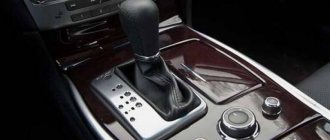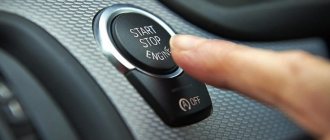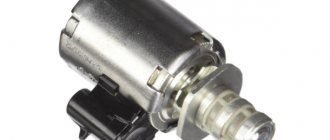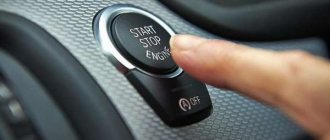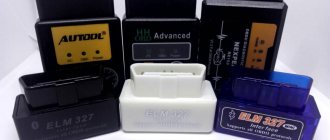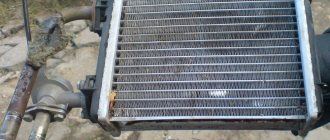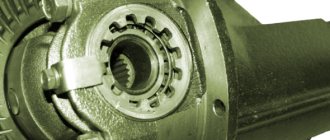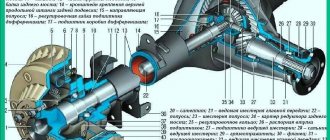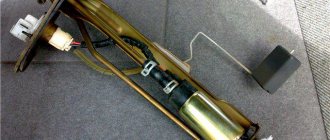Before a novice motorist gets behind the wheel and gains practical driving skills, it is necessary for the beginner to study the rules of the road and basic technical disciplines regarding the general structure of the car.
More precisely, you need to know about the operating principles of the main components that make up the car. Although the latter is not required to be studied according to regulations, this knowledge will not be superfluous for future motorists.
In this article we will look at how to drive an automatic car for beginners, the principle of operation of an automatic transmission, rules for using an automatic transmission, switching operating modes of an automatic transmission, etc.
Using other driving modes on an automatic for beginners
Modes “1”, “2” and “3” are selected based on the vehicle’s driving conditions. Some are convenient for towing heavy loads, while others are suitable for descending steep mountains. Let's look at each of them in more detail.
The inclusion of the “third” mode tells us that the automatic transmission operates in three-speed mode. In this mode, the car can move at any speed, but not higher than third. Driving in mode “Three” allows you to accelerate to a maximum of 150 km/h.
It is preferable to drive in this gear when your car is heavily loaded, as well as when driving around the city.
The “second” driving mode is also limited at upper speeds. When driving in mode “2”, only the second and first speeds are used. There are cars that combine “second” speed with “winter” mode. In this case, the car starts and moves only in second gear.
In most cases, the “deuce” is used on slippery roads, off-road or when towing. The maximum speed at this value is limited to 90 km/h. It is also convenient to move in second gear using engine braking when you have to go down a steep slope or a long climb has begun.
The “first” selector mode has the highest gear ratio, which is suitable for driving at low speeds, namely only in first gear.
At this speed, you can safely drive on loose snow, sand or washed-out roads at a speed not exceeding 45 km/h. This mode is also convenient for getting out of snow, sand or mud if the car is stuck.
If this happens and the car is slipping, then you should not apply gas. Try to “rock” the car by moving forward at first speed and back alternately. You can try to find better grip by turning the steering wheel from side to side. Also monitor the speed and revolutions on the tachometer, they should not be high, and the numbers on the speedometer should not be raised more than 30 km/h.
“Winter” and other special modes
Winter automatic transmission mode
After purchasing a new car, you may find additional positions on the transmission. Most often it is “Sport” or “Winter”. Let's talk about the latter, since it is found on almost all cars in Russia. It can be designated in several ways:
- snowflake (*);
- "HOLD";
- "Winter";
- "Snow"
- or the letter "W".
This program for your car is designed to start driving without slipping on a snowy road. In this case, the automatic system does not engage first gear, but starts the car immediately from second. To eliminate sudden changes in acceleration and skidding, subsequent gear shifts occur at lower engine speeds.
It is not recommended to try this mode in summer, as it causes the box to heat up more and is subject to a heavier load. In winter, heating is not so bad due to the cooling of the transmission oil. Also, you should not turn on “Snow” if you are moving along a cleared city highway with relatively good coverage. For residents of villages with predominantly dirt roads, it is more suitable for winter conditions.
“Snow” mode automatic transmission
However, you should refrain from driving on difficult roads with no asphalt. The automatic transmission really doesn't like this. Slipping is especially dangerous for her. In winter or summer (when driving on wet dirt roads), try to avoid areas where you risk getting stuck. If you do find yourself in a trap, do not try to get out of it in Drive mode. Almost all gearboxes have a “L” or “1” mode for this, which correspond to first gear in a manual transmission. You can also go to “Neutral” and carefully push the car, after placing boards or floor mats from the interior under the wheels.
Automatic transmission operating modes
Let's look at the automatic transmission modes.
P
Parking
. In this mode, the shaft and, accordingly, the drive wheels are blocked. Use this mode during long stops or when you leave the car. You can switch to this mode only after the car has completely (!) stopped.
Reminder!
To move the gear lever from position
“P”
to another position, you must press the brake pedal!
Attention! Never turn on this mode while the car is moving! This may cause the box to break!
If you leave the car on a relatively flat surface, then there is no need to use the handbrake. If the slope is steep enough, then to reduce the load on the elements of the parking mechanism, it is best to proceed according to the following scheme:
- Setting up while holding the brake, pull the handbrake,
- release the brake, the car will most likely move a little,
- switch the box to position “P”
,
Removal
- first switch the gearbox lever to driving mode,
- then, while holding the brake, release the handbrake
R
Reverse.
This mode is used for reversing. You can switch to this mode only after the car has come to a complete stop and the brake pedal is pressed.
Attention! Switching the box to this mode while moving forward will lead to failure of the gearbox and other elements of the transmission and engine!
N
Neutral gear.
This gear is used only for technical needs, when it is necessary to move the car over short distances with the engine running, for example, in a car service center. If you need to have your vehicle towed, see the section on.
Many people believe that when coasting down a hill, you can save some fuel by switching the transmission to this mode, but this is not true, because then you still have to switch to mode D
, which will put additional load on the box.
Also, when driving an automatic, it makes no sense to move the lever to the neutral position during short stops, for example at traffic lights.
D
Basic driving mode.
Most often, this mode is used to move forward. On an automatic transmission, this mode is suitable for driving at any speed available to the car, from “0” to maximum.
2
Only the first 2 gears.
This mode is recommended when driving on winding mountain roads or when towing a trailer or other vehicle. Do not switch to this mode if the vehicle speed exceeds 80 km/h.
L
First gear only.
This mode is used for particularly difficult road conditions, such as off-road driving. You should not switch to this mode if the vehicle speed exceeds 15 km/h.
Some tips for switching modes correctly
Before you start studying the special modes of your automatic transmission , you need to learn how to use the basic ones correctly. The selector is installed in additional modes much less frequently. The position of this “lever” can only be selected when the engine is running. If you are just starting to move, do this while warming up. If you need to reverse, you first need to stop, select a new mode and start moving.
Remember the procedure for choosing the required method of movement:
- Press the brake pedal to the floor.
- After this, press the button on the selector. Depending on the model and year of manufacture of the car, it can be located on the handle at the top, bottom or side.
As you can see, everything is quite simple. Beginners usually find it difficult to switch from Park to Drive. To do this you need to pass "R" and "N". This must be done by smoothly moving the lever and not stopping at inappropriate positions. The sound of the engine will alert you to the gear change. He will become more deaf. This usually happens within a couple of seconds.
Lock as a precaution when driving an automatic car
Driving an automatic for beginners requires careful attention to the vehicle's driving modes. Thus, you should remember a few simple rules:
The automatic transmission lever is designed with some safety measures
If the automatic transmission lever switches to certain modes without pressing the lock button, this means that the lever can be moved into these ranges both when the car is moving and when starting off. If the lever is moved to a certain mode only by pressing a button on the selector, then this indicates that some precautions must be taken to perform this action. Thus, with the selected driving mode “1”, it is possible to safely move the lever to position “2”, and then switch it to range “3” or “D” on the move, without stopping your vehicle
However, it is worth noting that switching the lever from the “Third” position to the “Second” or “First” is already accompanied by pressing the latch. This is done to prevent damage to the box if the driving mode is incorrectly selected. Otherwise, the machine will be subjected to significant overloads, which will inevitably lead to its breakdown.
Thus, with the selected driving mode “1”, you can safely move the lever to position “2”, and then switch it to the “3” or “D” range on the move, without stopping your vehicle. However, it is worth noting that switching the lever from the “Third” position to the “Second” or “First” is already accompanied by pressing the latch. This is done to prevent damage to the box if the driving mode is incorrectly selected. Otherwise, the machine will be subjected to significant overloads, which will inevitably lead to its breakdown.
Therefore, to correctly switch between modes in this order, it is necessary to either stop completely or slow down the speed of the vehicle. Thus, switching the lever from position “Two” to “Third” gear without using a locking button is impossible; compliance with restrictions is required. Namely, you cannot use such a combination when driving above a speed of 70 km/h, so as not to damage the transmission. Although in new automatic transmission models this nuance seems to have been removed, so switching when driving even at high speeds will not bring much harm, even if the switch is incorrect.
That's all we wanted to say on this issue. Driving an automatic transmission for novice drivers causes difficulties only at first, which cannot be said about a manual transmission. First you need to understand the modes of your transmission. In any case, all the necessary recommendations for using the automatic transmission capabilities of a specific car model are available in the service documentation. Such documents usually “come” with the car upon purchase, or can be found by make and body number on the Internet.
How to stop driving with automatic transmission correctly?
Stopping the movement of a car with automatic equipment also has its own characteristics. There are also rules here. If you don’t take into account the nuances, everything is simple - if you want to stop, just press the brake pedal. There is no need to switch gearbox modes while driving.
If you need to stop for a few moments at a traffic light or zebra crossing, stay in D mode. This will help keep your box intact. In this case, the brake pedal must be recessed.
In difficult road conditions (protracted traffic jams), it is possible to reduce the car’s gasoline consumption. If you realize that you will stand for more than half a minute, then you can switch to “Neutral”. Just do not release the brake pedal so as not to accidentally hit other cars. If traffic on the highway has stopped for a long time, you can let your right leg relax a little - switch to “P”.
How to start driving an automatic car lesson 2 AUTOMATIC
Today we will talk about how to start with an automatic transmission. 1) Get behind the wheel and check that the car should be in “P” mode - parking (you don’t have to use the handbrake), or “N” - neutral (then you need to use the handbrake). This is how easy it is to get going in a car with an automatic transmission.
How to drive an automatic vehicle at a traffic light to be first:
When the light turns green, press the gas pedal. The faster you press the pedal, the faster your car will start.
For many, it will be easier to comprehend the “basics” of a successful start in a car if you understand what happens inside the transmission as a result of their actions (pressing the clutch pedal, shifting gears). But in a manual transmission, to change gears, the driver needs to squeeze not only the clutch, but also “turn” the gearbox lever. In this case, the clutch must be kept pressed, and the accelerator (if the car does not stall) can be released. Then, to prevent the car from stalling, the accelerator should be held lightly for a while. It is especially difficult to start from an incline in a car equipped with a manual transmission. There are two main ways to start up a hill. Let's consider each of them separately. At the moment when you feel that the car has moved forward up the hill, and only the parking brake is holding it, release the handbrake button.
How to drive an automatic transmission?
However, driving an automatic transmission is not as simple as it seems at first glance, and therefore the question of how to drive an automatic transmission is far from idle. In this case, the engine should be started in the selector positions “P” or “N”. In other positions the car simply will not start. In this case, it is necessary to hold the car by pressing the brake pedal. However, turning on this mode is possible only when the vehicle speed is below 15 kilometers per hour. Before driving an automatic transmission off-road, it is better to turn on the mode in advance. Before driving an automatic transmission using this mode, you should remember that it forcibly does not allow the automatic transmission to shift higher than third gear. This legend arose from the fact that in the standard “drive” mode the car actually does not slow down due to the power unit.
How to drive off with a manual transmission at a traffic light with throttle shifting:
These include the ability to start from a stop, the ability to start up a hill and driving in reverse. Without mastering these three basic maneuvers, driving a car is simply impossible. First of all, you should understand that in order for the car to move, the rotating motor and the car chassis must be connected. Without going into the details of the design, let's just say that the clutch pedal in a car with a manual transmission is exactly what is needed to smoothly, without jerking, connect the engine and wheels. Learning to drive a car with an automatic transmission is not a very quick process. In some cases, it becomes necessary to quickly pick up speed with minimal slippage - for example, to overtake a car at a traffic light.
Just like a manual car, to drive a car with an automatic transmission, you need to start it and warm up the engine
It is also important to remember to release the car's handbrake.
Learning process
Automatic driving training includes a theoretical course and practical lessons with a driving instructor. In the class you will study traffic rules, the structure of an automatic car and the features of its operation. On the racetrack and in the city, learn how to start, brake, use the handbrake and reverse correctly. The number of classes depends on the chosen tariff.
When passing the automatic transmission test, o. is placed on the driver's license.
This means that the driver has the right to drive a car with an automatic transmission. To switch to mechanics, you will have to relearn and take your license again.
How to rebuild
The need to change lanes in traffic creates a lot of problems - you need to notice the reason for the maneuver in time, carry out the prescribed actions step by step, control the situation with the help of mirrors, change lanes without interfering with other road users. It is possible to achieve error-free maneuvering only through long-term training, which helps train muscle memory and bring reactions to automaticity. Sergey Moryakhin examines the topic in detail: he examines typical mistakes, gives instructions on execution techniques, shares tips, reinforces the material in practice, inviting the viewer to “ride” together around the city and in the process analyze real situations.
Read with this
- Automatic transmission diagnostics: what, where, when
- Tiptronic
- Rating of manufacturers of electric automatic machines by reliability: which ones are better
- Vehicle check
- Traffic controller gestures in pictures with explanations
- What to choose: automatic transmission or CVT
- Frozen lock in the car. how to open a frozen car lock
- Which is better: automatic or manual? pros and cons of automatic and manual transmission, how to choose
- Wheel width
- What is "safe driving"?
The main mistakes when using an automatic transmission
The main mistakes when using an automatic transmission
To drive a car with an automatic transmission installed, you need to acquire certain skills. The best way to do this is to undergo training at a driving school or get several practical lessons from experienced drivers.
Important! Before driving a new car for the first time, check the gearbox modification. If it is a traditional automatic transmission, you need to start smoothly. Robotic modifications with DSG or PowerShift units, on the contrary, like a more aggressive start to movement. In the latter case, after reaching a certain speed, you do not need to press the gas pedal any further.
Many drivers, while driving, pay attention only to fuel consumption, but with an automatic transmission, you also need to think about the safety of its components. If you do not take into account the features of the “smart” transmission, then the cost of gasoline will seem insignificant to you. Repairing this unit can seriously devastate your budget, so avoid the basic mistakes of beginners:
- aggressive driving style;
- sharp acceleration;
- careless driving on slopes and mountain roads;
- towing too heavy cars;
- attempts to start the car “from a pusher”;
- untimely replacement of transmission oil.
Remember that the “automatic machine” requires extremely careful treatment. Please keep this in mind when using your car. You should not start a car with it in the traditional Russian way (by pushing it). If you are used to a fairly aggressive driving style, you should give it up.
Automatic transmission requires extreme care
This type of transmission does not like cold starts at all. If you start driving in winter, make it a rule: before starting to move, move the lever several times to different positions. The brake must be applied while performing this procedure. This will help disperse the oil in the box and make it a little warmer. In summer this problem is not present, but still try not to accelerate during the first kilometers of driving; smooth movement will help the transmission warm up.
Also, a car with an installed automatic transmission requires more careful attention in terms of maintenance. It needs to be regularly checked for technical inspection and the oil in the box changed according to the manufacturer's recommendations.
Important! Boxes with a continuously variable variator cannot be repaired. If they fail, a complete replacement of the unit is necessary. Experienced technicians can fix minor breakdowns, but be prepared for the fact that in the near future you will still have to replace this part of the car.
Every year, automatic transmissions become more and more complex in their design. Almost every manufacturer has a car with a robotic transmission in its model range. If there is the slightest malfunction in their operation, you must contact an authorized service point. Only there they will be able to fix the damage and not make it worse.
Towing a car with automatic transmission
If towing is necessary, turn on the N mode. However, if the engine cannot be started, then it is better to avoid towing over significant distances - use a tow truck for this: if the engine is not running, the oil pump will also not work, and this will impair lubrication. The distance of travel by tow should not exceed 70 km. The speed should also not exceed 70 km/h.
Switch modes on the go. It is strictly forbidden to turn on the P and R modes while driving - damage to the gearbox, or even the engine, is guaranteed! It is also undesirable to switch to neutral while driving, because in this case all control modes are turned off, including the connection of the wheels to the gearbox, which can lead to skidding during braking. But in some situations, switching automatic transmission modes while driving is even necessary, as happens during the transition from mode 3 to mode 2, which ensures effective engine braking.
General recommendations
An inexperienced driver can operate an automatic transmission; the recommendations below will extend the life of the automatic transmission:
- You cannot put heavy loads on an unheated box. Transmission oil warms up more slowly than engine fluid. When driving a car with the specified type of gearbox, drive several kilometers at low speed.
- Avoid wheel slipping: do not press the gas sharply if the road surface is uneven.
- Try not to tow trailers or other cars.
- Avoid switching to neutral when the vehicle is moving.
Proper operation of an automatic transmission allows you to enjoy driving and prevents premature breakdown of the unit, allowing the mechanism to function normally.
For an experienced driver, driving a car with an automatic transmission is not difficult. Most often, difficulties arise for beginners who do not know all the nuances of the “machine”. Therefore, before getting behind the wheel of a car with an automatic transmission, a novice motorist should study its operating principle.
Additional features
When driving a car with an automatic transmission, you can often use additional elements.
What does this mean?
- “O/D” , this position is intended for acceleration and quick overtaking. Applicable to vehicles with more than three gears. This mode can be used on long climbs, then it will be easier for the motor to cope with the work.
- Kick-Down , used for sudden acceleration. But it is not advisable to use it from the start of the movement, since the box will receive too much load. Activating this position is very simple, just sharply press the gas pedal to the floor.
- "PWR/SPORT" is also intended for fast driving. This position is activated at high speeds. But it is worth remembering about the maximum fuel consumption at the same time.
- "Snow" is intended for driving in winter. Acceleration here begins immediately from second gear, bypassing first, thereby reducing the likelihood of slipping. Using the selected option, maximum safe movement on snow is ensured. And fuel consumption here is minimal. But it is still undesirable to use it in the summer in order to avoid overheating and further damage to the automatic transmission.
How long does it take to start driving at a driving school?
A cadet is allowed to learn to drive a car only with a driving school instructor. Otherwise, he faces a fine for not having a license, and the person allowed to drive his vehicle. Therefore, you should adhere to a simple algorithm and gain knowledge and skills sequentially:
- enter into an agreement with a licensed driving school for training;
- start theoretical lessons;
- approximately 3-4 weeks after the start of training, the group is distributed among driving school instructors for practical training;
- complete the full course and pass the internal test;
- successfully pass the traffic police exam and receive a driver's license.
Initially, time is allocated for an introduction to basic knowledge of traffic safety. After about a month, the cadets move on to practice and get behind the wheel of a car. Theoretical lessons will continue by this time, alternating with driving.
Useful links:
- "Tips for novice drivers"
- “Ten basic rules for safe driving in a modern city”
- “How to quickly get a license: buy, study, conditions. Advice from the director of a driving school"
Tweet
Call us and get a free consultation!
+7 (495) 122-00-15
Future motorcyclists can take the theoretical course at any of the 58
training classes of the Central Driving School of Moscow, located in all districts of Moscow in places of best accessibility.
To attend lectures, you can choose any of the offered options: weekdays - morning / evening, weekends - morning / afternoon
.
And you can also combine them and create an individual lesson schedule
!
To consolidate the material you have studied or work on missed topics, you can take advantage of online training
.
Motorcycle driving lessons at the driving school are held at indoor motor racing tracks
.
Moreover, classes take place all year round
, in any weather conditions.
During classes, all students are provided with
the necessary
protective equipment
.
The total duration of the practical motorcycle driving course is 18 hours. For these classes you can choose any day of the week (including weekends)
, from 7 a.m. to 10 p.m.
Practical classes are held on new Yamaha, KTM and Honda motorcycles
under the guidance of professional instructors and famous motorsportsmen.
During practical training you will learn:
- Drive confidently and choose the right pace.
- Maintain balance at slow speed in several ways and in combination.
- Correctly place your gaze when performing elements.
- Automatically perform all exercises.
Getting started correctly with automatic transmission
In recent years, more and more cars are equipped with a START-STOP-Engine (SSE) button, which turns on the ignition and starts the engine. The system is advantageous in that it simultaneously serves as an anti-theft agent that responds to the car’s “native” electronic key: if it is not inside the car, the loop antenna in the doors will lock the locks and stop the engine.
The SSE system can be installed either factory-installed or independently.
Options for starting the engine with the SSE button:
- With the turn of a key and the press of a button.
- Without using a key.
- Using the brake pedal.
- Without using the brake pedal.
- With or without delay start.
The sequence of actions to set the car in motion will be as follows:
- We sat in the driver's seat and buckled up.
- Adjust the seat position. To do this, you need to move it away from the steering wheel so that, with the backrest positioned at about 100⁰, you can easily reach the pedals with your feet (your legs should be slightly bent). The knees are at the same level as the hips. There should be a gap of 2 fingers between the seat and the bend of your knees, and your buttocks should be as close to the back of the seat as possible.
- When adjusting the seat correctly, your hands should be in the position: the right hand is “3 o’clock”, the left hand is “9 o’clock”, if you imagine the steering wheel as a watch dial.
Correct seating in the car - Set up mirrors. All three mirrors should complement each other as much as possible, minimizing the “dead zone” inaccessible to view. They are configured during parking.
- In the left mirror, when you tilt your head to your shoulder, you should be able to see the rear fender of our car and the road surface with markings. The road must occupy at least 60% of the reflection in the mirror.
- In the right mirror, when the head is tilted to the longitudinal axis of the car, the rear fender should be visible, and with the head in a normal position, part of the rear bumper should be visible.
- The horizon lines in both mirrors are set according to the principle of 40% - sky, 60% - earth.
- The interior mirror brings together the information received by the driver, complementing the views in the left and right mirrors. To adjust it, take a comfortable position in the chair and adjust it so that the rear window of the car is displayed as much as possible.
- Sometimes round parabolic reflectors are glued onto mirrors to increase the viewing angle. But it is better for novice drivers not to use them, as they distort the distance to real objects.
- Make sure that the automatic transmission lever is in the “park” position P. It is in a different position - switched to the indicated ones!
Gearbox lever in park position - Press the brake pedal all the way, start the car with the key or the start button. The brake pedal is still pressed!
- The gearbox mode selection lever is switched to “drive” mode, or D.
Now you can gradually release the brake pedal - the car will start moving even without boosting the engine with the gas pedal.
Be sure to watch the video for more details:
Which driving school should a woman choose?
The following tips will help you decide on a school:
- Visit the office. Ask questions about what is included in the program, details about road practice and conditions, instructor credentials, program accreditation status, and the school's level of responsibility.
- Look for a school where there is no rush in the learning process. Behind the wheel training is critical. Not all drivers are the same and some will require additional practice.
- Find out about the school's cars. It is unlikely that anyone will want to drive old cars. It is recommended to choose a driving school with new cars so that the training is comfortable.
- Make sure there is enough training. If a driving lesson lasts less than an hour, it is not enough. Lessons should be planned in advance based on the driver's current experience.
- Make sure the school has a good reputation. To do this, you need to read reviews on social networks and on thematic forums.
An instructor in a good driving school knows exactly how a woman can learn to drive a car from scratch and will find an approach regardless of her character and skills.
Where to start?
It would seem that a car with an automatic transmission should perform all the main functions for the driver. But if a motorist is a beginner, naturally he wonders how to learn to drive an automatic car?
Instructions:
- Customization for yourself. When you get into a car, you should first of all adjust the seat to suit you in order to feel comfortable while driving. Check how the mirrors are configured and, if necessary, adjust them. Because when performing various maneuvers, it is necessary to constantly monitor the situation using the mirrors.
- Launch. In order to start the engine in operating condition, you need to turn the ignition key, then depress the brake pedal, and then switch the selector to the required mode. You need to remember that the car starts when the parking position is selected. After this, the drive position is selected, the brake pedal is removed and the car begins to move slowly.
- Movement. To accelerate the car to the desired speed, the gas pedal is already used. And if you need to make a forced stop, for example, in a traffic jam or at a traffic light, then you need to constantly press the brake pedal, otherwise the car will roll slowly. This is the peculiarity of the automatic transmission.
This factor is quite convenient. Because the car will not stall at the first start, and will not roll down on uneven roads.
But in addition to knowing how to start and stop a car, it is important to feel confident on the roads and navigate various situations. Therefore, you need to undergo training with an instructor, and experience will teach you everything else.
Although many experienced motorists express many advantages in favor of mechanics, the latest automatic transmissions are gradually beginning to supplant established gearboxes. This is due to the fact that they have more and more advantages, for example, reduced fuel consumption. But still, everyone makes their choice in favor of where they will be more comfortable.
Basic rules for driving a car with automatic transmission
- In parking mode, no movement of the vehicle is possible, including in tow. The controls are disabled, the output shaft is locked, and the drive wheels are also locked.
- In neutral mode, all controls are disabled. If the output shaft locking mechanism is disabled, the vehicle can be moved freely. Engine starting is also allowed.
- Reverse mode R is under no circumstances engaged while driving forward! This will immediately cause breakdown of the automatic transmission. First he stops his car.
- The “drive” range, or D. All gears are used in it, except for overdrive. Recommended for driving on flat sections of trails, without sharp ascents and descents. Provides the ability to get moving. This mode has subranges: mode 1, mode 2, mode 3.
Brake pedal
Since a car equipped with an automatic transmission does not have a clutch pedal (it turns on automatically when the required engine torque is reached), movement begins after the brake pedal is released.
Factory engine settings allow you to start moving even without pressing the gas pedal after releasing the brake pedal. Gas is added to move to a higher transmission stage.
Brake pedal
The brake pedal also regulates the speed limit when driving on roads during coasting descents from hills. In position P (parking), the hand brake does not need to be applied, since the wheel drive is in rigid coupling with the gears of the automatic transmission, and a very large external force is required for the car to move.
